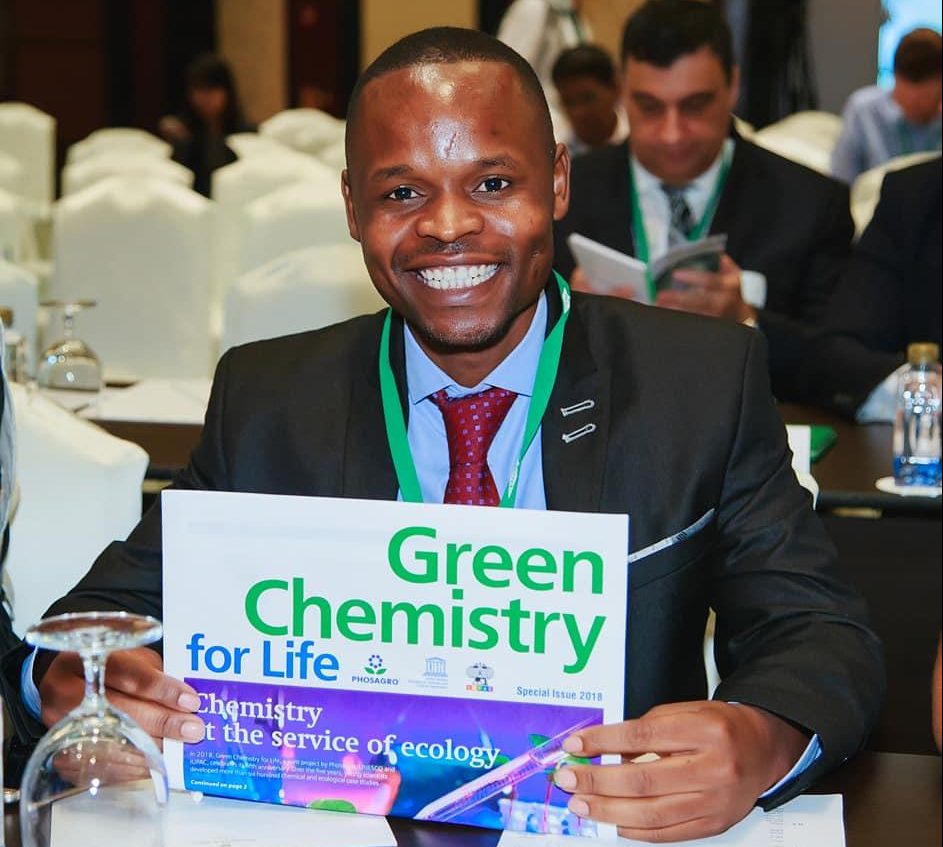Editor: Please describe your innovation in detail using simple terms.
Dr Mehlana: Carbon dioxide emissions from various sources is the greenhouse gas causing the greatest environmental concerns. The increase of these emissions originates from the burning of coal, oil and natural gas. Our aim is to develop technologies that are efficient in capturing and converting carbon dioxide to chemicals such as formic acid and methanol that can be used as starting raw materials by the chemical industry. To achieve our goals we deign materials which have pores. These pores are the ones that are responsible for capturing the carbon dioxide that is emitted from various industrial activities. Within the pores of these materials, there are sites which are made up of catalysts which can convert the greenhouse gas into formic acid or other fuels.
Editor: Why, in your opinion, did the jury single out your innovation?
Dr Mehlana: There is an urgent need to find solutions to the ever-increasing concentrations of carbon dioxide in the atmosphere. My project which is based on porous systems which can capture carbon dioxide from the point of emission and convert it to high-value chemicals seeks to provide some of the solutions to global environmental problems. This is meaningful research with the potential of transforming basic sciences into solutions that can solve issues faced by our society.
Editor: Why did you become interested in this subject?
Dr Mehlana: I am personally interested in tackling global challenges, and the issue of carbon dioxide is a topical issue which requires young people like myself to provide solutions. Africa is the hardest hit by climate change, it is imperative that as African scientists we contribute towards developing technologies that can fight climate change and global warming.
Editor: How did you get into fundamental science? When and why did you decide to become a scientist?
Dr Mehlana: I got into fundamental science at a young age. I decided to become a scientist at the age of 13.
Editor: What important problem can your invention solve, and what specific benefit does it have?
Dr Mehlana: If we manage to capture carbon dioxide from the point of emissions we will be able to tackle climate change and global warming. The invention also provides starting raw materials for the chemical industry. After capturing carbon dioxide we are converting it to formic acid which is a building block for manufacturing a wide range of chemicals that are useful in our everyday lives
Editor: How and why did you decide to become a chemist?
Dr Mehlana: I decided to become a chemist from the very day our high school teacher introduced us to the periodic table. I remember very well that we were asked to know the first 20 elements of the periodic table.
Editor: How do people living in your country address environmental problems every day? For example, are conscious consumption, waste sorting, water, electricity and paper saving, or refusing plastic bags popular in your country?
Dr Mehlana: Waste disposal is an issue. But in my country, we try to collect waste material for recycling. For example, glass bottles from beverages manufacturing companies are recycled. Access to clean water has been a major issue in Africa and Zimbabwe is no exception to this issue. The government ensures access to clean and safe water in rural areas through the provision of boreholes. In towns and cities, the water is treated with chemicals before it is supplied to consumers. The issue of waste plastic is a major environmental problem. Some plastics are not easily biodegradable and they exist for a very long period of time up to 500 years. Most of these waste plastics have found their way into the seas and oceans and the accumulation of microplastics is a threat to the lives of creatures found in the sea and oceans. In some countries such as India and the UK, waste plastic is now used to make road surfaces after blending it with bitumen. In Zimbabwe, we are still using plastic bags but I believe that it is our role as scientists to inform the policymakers about the dangers posed by waste plastic so that proper legislation can be put into place.
Editor: What global environmental threat do you find most dangerous?
Dr Mehlana: I think climate change and global warming threaten our existence on this planet.
Editor: Do you believe any ways to protect the environment that would solve global environmental problems will be found? What fields would such breakthroughs involve?
Dr Mehlana: I strongly believe that by engaging scientists, global environmental problems will be solved. Chemists should be at the forefront in carrying out research that is meant to address the global environmental problems that we are facing. We need to work on reducing the amount of carbon that we are emitting to the environment in the short term and the long term goal is to come up with technologies that are green to the environment. As such, efforts must be directed towards clean technologies. Currently, we are using fossil fuels as our source of energy and this is the highest contributor of carbon dioxide into the atmosphere. We can invest more in hydrogen and electric technology to power our vehicles. It is also possible to generate a lot of energy from solar power. But we must also understand that a carbon-free environment is not possible in the near future, therefore, it is imperative to capture and recycle carbon that is emitted from different industrial activities. The technologies that are also used in the industry must be more efficient so that they do not emit a lot of carbon into the environment. To sum it up, yes, it’s possible to solve global environmental problems, this requires the participation of everyone, the governments, private sector, academia and society, and we all need to work towards saving our planet.


